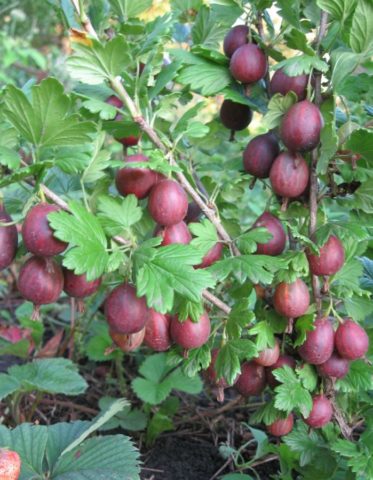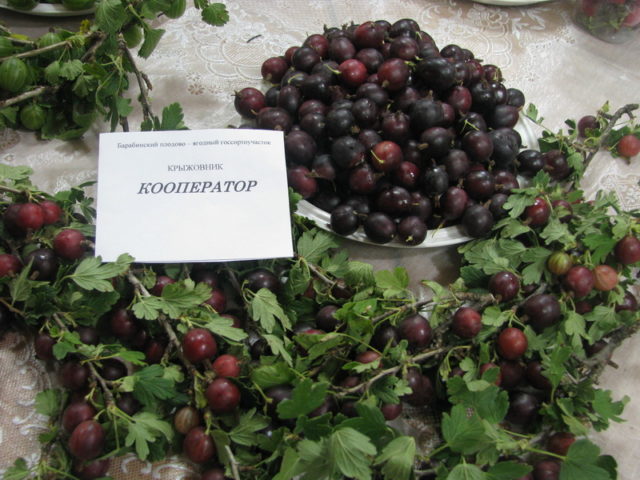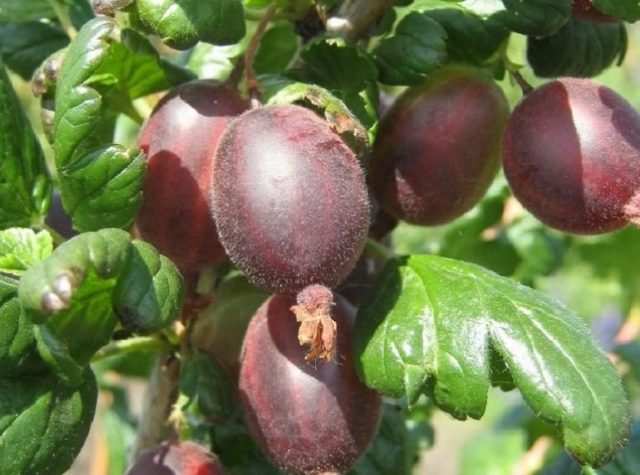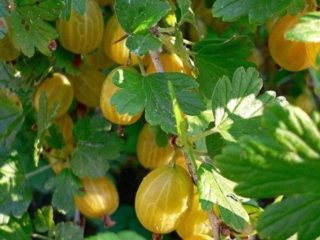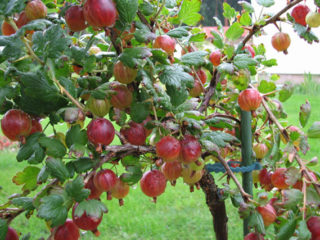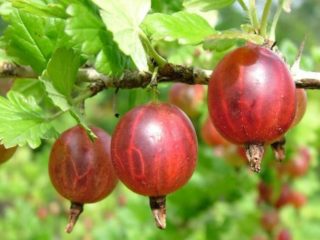Content
Gooseberry Cooperator is valued among gardeners not only for its unpretentiousness, high yield, and dessert taste of the berries, but also for the aesthetic appearance of the bush. Another advantage of this variety is that it has almost no thorns.
Description of gooseberry Cooperator
Gooseberry Kooperator (Ribes uva-crispa Kooperator) was obtained in 1991 as a result of crossing two varieties - Smena and Chelyabinsk green.
The height of the bush is about 1 m. It is neat, with dense, medium-spreading branches up to 120 cm long. The description of the Kooperator gooseberry variety is confirmed, among other things, by reviews from gardeners:
Younger shoots are pubescent, light green, medium thick and slightly curved. Single small thorns are located at the bottom of the branches, so they do not interfere with harvesting at all. The lower part of adult shoots of this variety has a characteristic pinkish-crimson tint.
Gooseberry Cooperator has large and medium-sized leaves with five pointed lobes. The shiny, rich green foliage looks impressive due to its fringed edging. The central blade has additional teeth.
Small and medium cup-shaped flowers are collected in inflorescences of 2 or 3 pieces. They are usually yellowish-green, with a pinkish tint, but pale yellow ones are also found. During flowering, the plant looks very beautiful - it bursts with many inflorescences
The description of the gooseberry variety Kooperator is well illustrated by the photo:
The dark cherry striped berries of this variety weigh, on average, 3 - 5 g, and are also very large - up to 8 g. They have an unusual shape for a gooseberry - not round, but elongated, pear-shaped; without pubescence, with thin skin. The fruit stalk is long.
A self-fertile bush (42.4%) does not require replanting with other pollinating varieties nearby, although it shows higher yields with them.
Ideal for cultivation in two regions of Russia with rather harsh climatic conditions: Ural (No. 9) and East Siberian (No. 11).
Drought resistance, frost resistance
The variety is known among gardeners for its winter hardiness and drought resistance. Even at high temperatures, the bush is rarely watered, since it has a powerful and deep root system. In addition, it tolerates frosts down to -30 °C well, so it is recommended to grow the crop in the Urals, in particular in Chelyabinsk. With the onset of stronger cold weather, the Kooperator variety may freeze slightly (especially the root system), which is why its yield subsequently decreases.
Fruiting, productivity
Gooseberry Cooperator amazes with its fruit size and yield.
Cooperator is considered a medium-late variety in terms of fruit ripening. One plant produces approximately 4 - 8 kg of berries (bucket) over the summer. On average, the yield is 12 t/ha, but this figure can be almost twice as high - 23 t/ha, that is, from 3.7 to 6.9 kgf of a bush, or 0.9 - 1.3 kg/m2.The fruits of this variety are tightly attached to the branch and do not fall off.
Kooperator gooseberries have a sweet and sour, pleasant taste, which experts rate as 5 points.
Their skin is thin, but at the same time strong, which provides them with good shelf life and transportation.
The variety is suitable for fresh consumption and canning. Delicious confiture, jam, and compote are made from Kooperator gooseberries.
Advantages and disadvantages
Advantages of the Cooperator variety:
- Good tolerance to cold and heat;
- Resistance to diseases, in particular to powdery mildew;
- High yield;
- Large berries with a dessert taste;
- A small number of thorns at the bottom of the bush does not interfere with harvesting;
- Self-fertility.
Gardeners highlight few disadvantages. Those who like to eat gooseberries at the beginning of summer are not satisfied with the ripening time. There are few seeds in the berries, but they are large. In addition, if gooseberries of the Cooperator variety are not sprayed for preventive purposes, they may develop anthracnose and septoria.
Features of reproduction
Gooseberry Cooperator is propagated using woody cuttings, which are cut in the fall and stored in a cool place, for example, in an underground or refrigerator, until spring. The planting material prepared in this way is planted in small greenhouses and covered with glass jars, plastic bottles or film.
Another method that is no less effective is the use of layering. At the beginning of summer, several tops of young shoots are bent to the ground, secured and lightly dug in. After 2 months, the cuttings will give roots and will be able to grow on their own.
Planting and care
Gooseberry Cooperator is not very picky about the planting site. It is important to follow the standard set of recommendations for the plant:
- Provide access to sun;
- Protect the bush from drafts;
- Avoid excess moisture;
- Plant gooseberries in soil with a neutral or alkaline environment. The crop prefers loam, soddy-podzolic soil and black soil.
Planting the Cooperator variety is also easy. To do this, dig a hole 50 - 60 cm deep and 45 - 50 cm wide at the selected location. Then feed is applied: rotted manure (10 kg), superphosphate (50 g), potassium sulfate (50 g). This amount of fertilizer is enough for the good development of the seedling for 2 - 3 years. The roots are carefully spread evenly over the hole. The root collar is buried 2 cm - this will help new shoots grow faster.
It is better to plant after sunset, and in the morning to loosen and then mulch the root circle. The second half of autumn is considered the optimal time. In the spring, the active development of the gooseberry root system occurs, and if you plant it in April, the plant will devote all its energy to the growth of shoots.
Growing rules
Gooseberry variety Kooperator is quite unpretentious. However, if you follow a few simple rules, this will have a beneficial effect on the taste and quantity of berries.
There are the following secrets of growing crops:
- Moderate watering;
- Feeding;
- Loosening;
- Timely pruning;
- Garter;
- Protection from rodents.
The Kooperator gooseberry tolerates even dry periods without frequent watering. The plant does not tolerate excess moisture at all: its root system immediately begins to rot.
The schedule for watering the bush during flowering and fruit setting is 2 - 3 times. If you overdo it, the taste of the berries will deteriorate: they will not be sweet.An adult plant needs to be watered only in case of a long absence of precipitation.
Fertilizer is applied when planting gooseberries, so organic and mineral fertilizer is only needed for bushes older than 3 years.
The roots of the Kooperator variety lie deep (20 - 30 cm) and need access to air. It is recommended to loosen the bush approximately 5 times per season to a depth of 3 - 5 cm.
In the fall, after the berries have fallen, it is necessary to perform sanitary pruning of the gooseberries. Dried, diseased, as well as old shoots that are more than 5-6 years old are removed.
Timely weeding and hilling of the bush will help protect gooseberries from rodents. In addition, you can spray the plant with insecticides.
Gooseberry Cooperator in regions with a mild climate does not need to be covered for the winter: it is enough to mulch the root circle with compost, peat or humus with a layer of 10 - 12 cm. In harsh climates, it is recommended to cover the plant with agrofibre stretched over a metal bracket, or bend the bush to the ground. It is very important that in winter the gooseberries are completely covered with snow.
Pests and diseases
With proper care, Kooperator gooseberries are resistant to diseases, in particular powdery mildew. There is a possibility of infection with septoria and anthracnose. Sawfly beetles can eat the foliage of shrubs.
To avoid this, in order to prevent diseases and clear away wintering pests, every spring it is recommended to spray the Kooperator gooseberry with boiling water, folk remedies or insecticides. The plant is saved from anthracnose by 1% Bordeaux mixture.
Conclusion
Gooseberry Cooperator is a variety characterized by high yield and resistance to unfavorable climatic conditions. Gardeners choose it for its large and tasty berries.
Reviews about the gooseberry variety Kooperator
